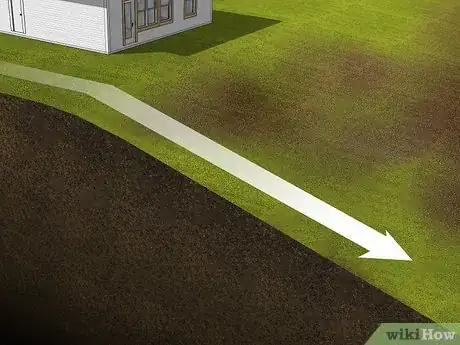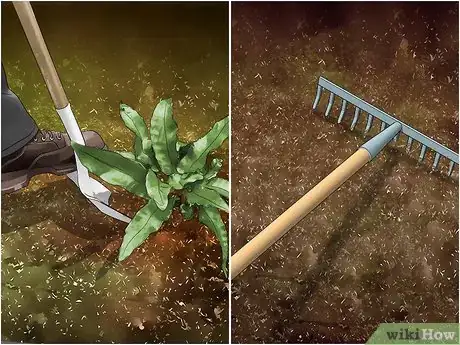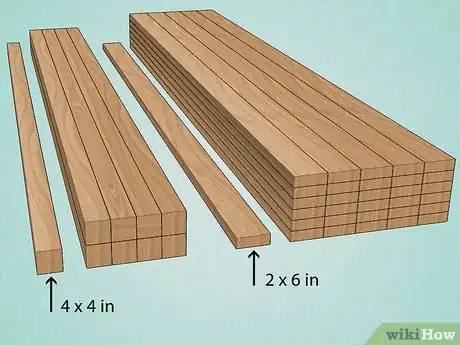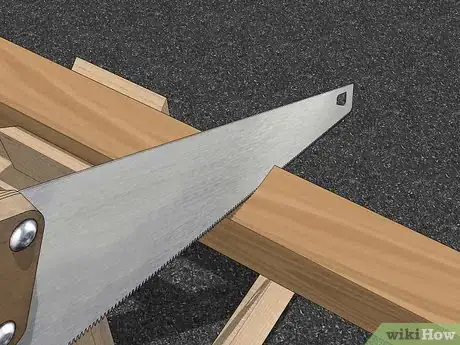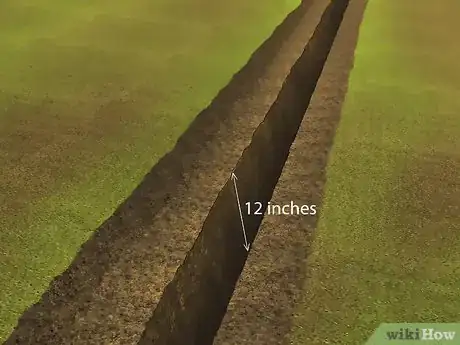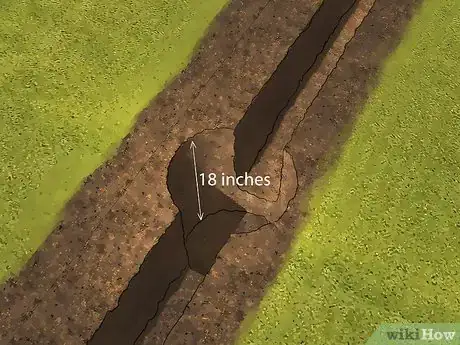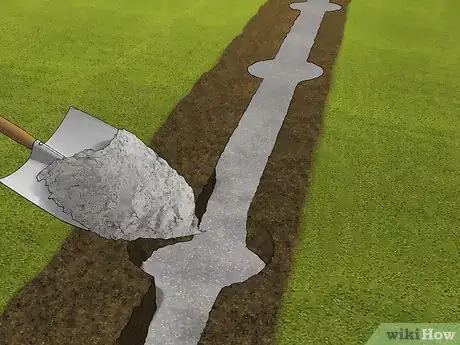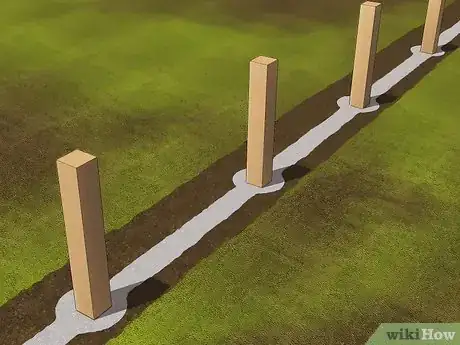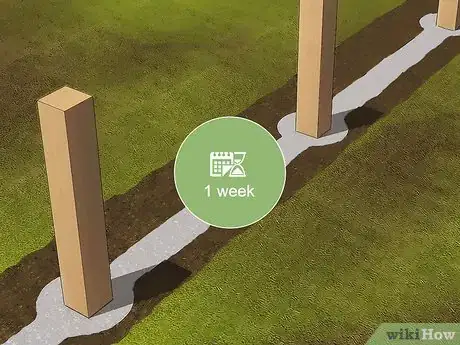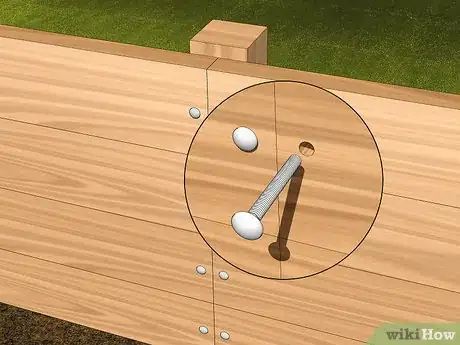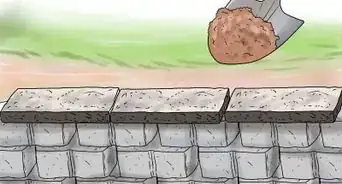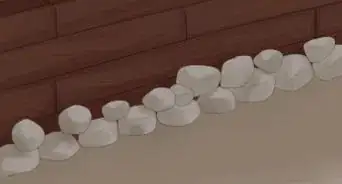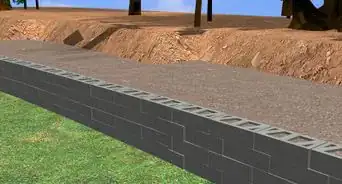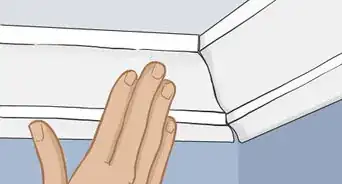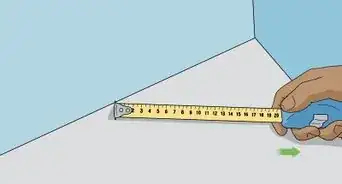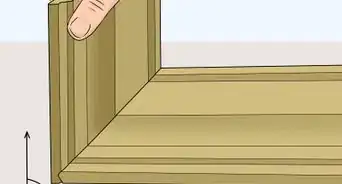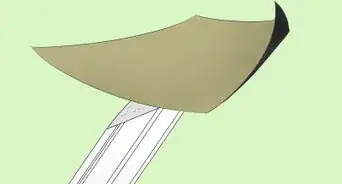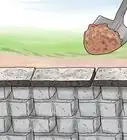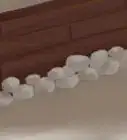This article was co-authored by Agustin Renoj. Agustin Renoj is a Home Improvement Specialist with Renoj Handyman based in the San Francisco Bay Area. With over 18 years of construction experience, Agustin specializes in carpentry, painting, and exterior, interior, kitchen, and bathroom renovations. Renoj Handyman is a family-owned business that consists of craftsmen trained in all areas of construction.
There are 7 references cited in this article, which can be found at the bottom of the page.
This article has been viewed 298,807 times.
Building a wood retaining wall is a great way to keep your topsoil from washing away down a slope. Not only that, you can turn it into a terraced garden for planting anything from vegetables and flowers to small shrubs and trees. Although a wood retaining wall is relatively simple to build and doesn't require professional skills, you will need some knowledge of basic tools and a bit of perseverance.
Steps
Gathering Your Materials
-
1Find a location with a steep slope affected by erosion. These benefit the most from retaining walls[1] . Signs of soil erosion include exposed roots, patches of dead land, landscape changes (more bugs or worms, more rocks, soil that is suddenly denser and harder), and clumps of grass floating in nearby water. Just avoid locations where water tends to ooze up or stand—these are not good choices as the water will rot your wall and ruin it rather quickly.
- Select a location where the excavated soil will be roughly equal to the backfill material needed behind the wall.
-
2Clear and rake the area where you want to build your wall. Start by removing any garbage and rocks. Afterward, remove any plants by digging in a circle around the roots, taking care to cut through as many as possible. Once you've cut them, jam the shovel underneath the plant's roots and lever it up and out of the ground. After the area is clear, rake it smooth.
- Continue raking the soil until it's level.
- Destroy as many roots as you can to prevent them from regrowing.
Advertisement -
3Purchase your wood pieces from a home hardware store. Determine how many 4 by 4 inch (10 cm × 10 cm) posts—spaced 3 feet (0.91 m) apart—you need for your retaining wall and purchase them from a local home hardware store. Afterward, purchase 2 by 6 inch (5.1 cm × 15.2 cm) boards to extend between your posts. Either have the staff cut your wood to size or purchase larger pieces to cut them to size on your own.
- Give yourself an additional 18 inches (46 cm) on top of your post height to go in the ground.
- If your retaining wall is going to be 40 feet (12 m) long, you need 14 posts—40 (length of the wall) divided by 3 (space between each post)—for your wall. If it's going to be 5 feet (1.5 m) tall, make sure your posts are 5 feet (1.5 m) tall with an additional 18 inches (46 cm) on top.
- In the previous example, if your wall is 5 feet (1.5 m) tall, you need to stack 10 pieces of 2 by 6 inch (5.1 cm × 15.2 cm) boards vertically—5 feet (1.5 m) divided by 6 inches (15 cm)—to create the height of the wall. Ask the staff to cut you 10 pieces 3 feet (0.91 m) long for every 2 posts.
-
4Cut your wood posts to length if they aren't already. If you didn’t get your wood pieces cut at the home hardware store, cut your posts to the size with a circular saw. Hold each piece of wood still with your non-dominant hand and guide the saw forward with your dominant hand. Apply downward pressure to each wood piece as you cut to keep it steady. After you're done, set your posts aside for later.[2]
- Let the shortest piece of your wood hang to prevent jamming.
Digging Your Holes
-
1Mark your post hole locations on the ground with chalk. Each post should be 3 feet (0.91 m) away from each other—start by marking the first post location with chalk at one end of the wall. Now, move in 3 foot (0.91 m) increments along the line until you reach the end.[3]
- Use a taut string and stakes or a snapped chalk line to help you create a straight line.
- If you need to extend your wall with another post to create the final 3 feet (0.91 m) then do so.
- Space your posts 16 to 18 inches (41 to 46 cm) apart for load-bearing walls, which are walls that support something aside from their own weight such as a roof.
-
2Dig a 12 inch (30 cm) deep trench between your post locations. Start by using a D-handle shovel to loosen the dirt along each side of the trench. Once it's loose enough, dig out the middle with a trench shovel. Continue loosening and digging into the soil with each of your shovels.[4] [5]
- Call your local utility services number at least 3 to 4 days before digging to ensure it's legal and won't damage underground structures, such as power, sewer, water, or gas lines.
- Consider renting heavy equipment to dig your trench.
- Saw through large roots with a reciprocating saw or using the tip of your trench shovel.
- Use a steel bar to loosen rocks.
-
3Dig 18 inch (46 cm) deep holes for your posts. Thrust your shovel into the soil and jiggle it forward and backward and side to side. Once the soil is loosened, start digging down into the ground. Grip the middle of the shovel's handle with your non-dominant hand and the top of the handle with your dominant hand.[6]
- Use a steel bar to knock rocks loose.
- Remove large sections of loose soil with a clamshell digger.
- Saw through large roots by thrusting your shovel down into them or using a reciprocating saw.
Installing Your Posts and Wall
-
1Fill the holes with cement and then level them. Mix your cement and water in a wheelbarrow while following manufacturer's directions. Afterward, gently tilt the wheelbarrow forward and pour the cement into the holes.[7]
- Use a hand float the level the surface of the cement with the ground when you're done.
-
2Insert the posts into the holes immediately. After inserting the posts into the holes, press them down to make sure that their bottoms are flat against the bottom of the hole. Do this as quickly as possible and make sure that they're perfectly vertical. If you have to, hold them in place with your hands until they settle into a vertical position. Make sure that they remain in place after letting them go.[8]
- You can also place 2 by 4 inch (5.1 cm × 10.2 cm) boards on either side of the posts to hold them in place.
-
3Allow the concrete to dry for 1 week. Once your posts are securely settled into the concrete, give the concrete time to cure. By waiting for a week, you're ensuring that the posts will be sturdy enough to support the weight of the rest of the fence.[9]
- Read the directions on the package of concrete mix for specific curing instructions, as these can vary between brands.
-
4Connect your 2 in × 6 in (5.1 cm × 15.2 cm) boards between your posts. Use carriage bolts and an electric drill to connect your boards to the outside of your posts. Take care to ensure that the leftmost and rightmost part of each board aligns with the vertical center line of each post they connect to.
- If your boards are shorter than the length between your posts, cut them so that they sit in the middle of each post.
- Place 16 penny nails or deck screws between each deck board to space them enough for expansion.
-
5Fill the area behind your boards with soil until it reaches the top of the boards. Use the soil you removed from the trench to fill the area behind the boards. If you need more, purchase some from a home and garden store. Be sure to pack the soil down firmly when you're done.[10]
- If you need to purchase additional soil, make sure it's a similar composition as the soil from your trench.
Expert Q&A
-
QuestionWhat is a retaining wall for?
 Agustin RenojAgustin Renoj is a Home Improvement Specialist with Renoj Handyman based in the San Francisco Bay Area. With over 18 years of construction experience, Agustin specializes in carpentry, painting, and exterior, interior, kitchen, and bathroom renovations. Renoj Handyman is a family-owned business that consists of craftsmen trained in all areas of construction.
Agustin RenojAgustin Renoj is a Home Improvement Specialist with Renoj Handyman based in the San Francisco Bay Area. With over 18 years of construction experience, Agustin specializes in carpentry, painting, and exterior, interior, kitchen, and bathroom renovations. Renoj Handyman is a family-owned business that consists of craftsmen trained in all areas of construction.
Home Improvement Specialist Mainly when you build a retaining wall, it's because you have a slope and you want to prevent dirt from running down into your driveway or the street.
Mainly when you build a retaining wall, it's because you have a slope and you want to prevent dirt from running down into your driveway or the street. -
QuestionHow do you make sure a retaining wall will last?
 Agustin RenojAgustin Renoj is a Home Improvement Specialist with Renoj Handyman based in the San Francisco Bay Area. With over 18 years of construction experience, Agustin specializes in carpentry, painting, and exterior, interior, kitchen, and bathroom renovations. Renoj Handyman is a family-owned business that consists of craftsmen trained in all areas of construction.
Agustin RenojAgustin Renoj is a Home Improvement Specialist with Renoj Handyman based in the San Francisco Bay Area. With over 18 years of construction experience, Agustin specializes in carpentry, painting, and exterior, interior, kitchen, and bathroom renovations. Renoj Handyman is a family-owned business that consists of craftsmen trained in all areas of construction.
Home Improvement Specialist Drainage is very important when you build a retaining wall. If you don't have proper drainage, the water pressure can push your retaining wall until it cracks or falls.
Drainage is very important when you build a retaining wall. If you don't have proper drainage, the water pressure can push your retaining wall until it cracks or falls. -
QuestionWhen setting the 2x6 to the post do I need to leave a gap between the boards to allow for expanding, and if so, what size gap is best? Or can they be stacked on top of each other?
 Andrej WaliłkoCommunity AnswerI'd recommend putting a 16 penny nail or a deck screw between the boards to space them for expansion. If you are worried about dirt coming through that space, you could put landscaping fabric on the hill-side of the wall.
Andrej WaliłkoCommunity AnswerI'd recommend putting a 16 penny nail or a deck screw between the boards to space them for expansion. If you are worried about dirt coming through that space, you could put landscaping fabric on the hill-side of the wall.
Warnings
- If you are using a heavy duty drill with extensions, avoid applying undue pressure as it can cause the bit to snap.⧼thumbs_response⧽
- Always wear safety goggles and gloves to avoid injury.⧼thumbs_response⧽
Things You'll Need
- 4 by 4 inch (10 cm × 10 cm) posts, 2 by 6 inch (5.1 cm × 15.2 cm) lumber
- Gravel
- Trowels
- Shovel
- Carriage bolts
- Circular saw
- Screwdriver and a drill
- Rake
References
- ↑ Agustin Renoj. Home Improvement Specialist. Expert Interview. 13 January 2021.
- ↑ https://www.familyhandyman.com/tools/circular-saws/circular-saw-tips-and-techniques/view-all/
- ↑ https://extremehowto.com/build-a-retaining-wall
- ↑ Agustin Renoj. Home Improvement Specialist. Expert Interview. 13 January 2021.
- ↑ https://youtu.be/tgRoxIzqLRI?t=84
- ↑ https://www.familyhandyman.com/garden-structures/fences/how-to-dig-a-hole-pro-tips/view-all/
- ↑ https://www.familyhandyman.com/masonry/pouring-concrete/how-to-pour-concrete/view-all/
- ↑ https://www.familyhandyman.com/landscaping/retaining-wall/how-to-build-a-treated-wood-retaining-wall/view-all/
- ↑ https://www.familyhandyman.com/landscaping/retaining-wall/how-to-build-a-treated-wood-retaining-wall/view-all/
About This Article
To build a wood retaining wall, clear the area where you want to build, measure the length of the space, and buy enough boards and posts to complete the wall. Next, mark the ground with chalk every 3 feet to indicate where to drive the posts. Then, dig the holes for the posts, fill them with wet cement, and insert the posts immediately. Finally, give the concrete 1 week to set before adding the connecting boards between the posts. For tips on adding the connecting boards to complete the wall, read on!
